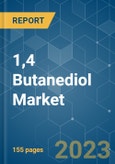Due to the disruption in the chemical goods supply chain during the pandemic, which raised the price of raw materials, the COVID-19 pandemic had a significant negative impact on the market. However, the market is projected to grow steadily, owing to increased activities of the textile industry in 2021.
Key Highlights
- Over the short term, increasing demand for tetrahydrofuran (THF) for spandex fibers, and increasing demand for polybutylene terephthalate (PBT) from various industries are major factors driving the growth of the market studied.
- However, the shutdown of 1,4 butanediol plants throughout the years is a key factor anticipated to restrain the growth of the target industry over the forecast period.
- Nevertheless, the rising development of bio-based BDO, and reducing the carbon footprint of clothing are likely to create lucrative growth opportunities for the global market soon.
- The Asia-Pacific region is expected to dominate the market and witness the highest CAGR during the forecast period.
1,4 Butanediol Market Trends
Growing Demand in the Textile Industry
- 1,4 BDO is used as an adhesive in leather, plastics, polyester laminates, and polyurethane footwear. 1,4-Butanediol is an immediate chemical used in the production of Thermoplastic polyurethane (TPU) which is further used in the making of Synthetic leather sole material.
- Tetrahydrofuran (THF) is used for the production of spandex fiber which has captured the garment industry. Spandex is a lightweight, soft smooth synthetic fiber that has a unique elasticity. The material is used in making compression garments: motion capture suits, Surgical hoses, and Support hoses.
- This is also a useful fabric for hospitality and industrial organizations. Spandex fabrics are mostly used in garments where comfort and fit are required like hosiery, swimsuits, exercise wear, socks, undergarments, gloves, cycling shorts, specialized clothing like zentai suits, denim, and sports equipment, etc.
- The Industrievereinigung Chemiefaser estimates that the global production of textile fibers increased from 108.30 million metric tonnes in 2020 to 113.60 million metric tonnes in 2021.
- The global sports equipment market has been witnessing significant growth in the recent past. According to Statista Consumer Market Outlook, the global sports equipment market is projected to reach USD 126.54 billion in 2021 to USD 159.41 billion in 2026.
- For instance, the Government of Australia is planning to invest USD 230 million in sports and physical activity initiatives over the next five years. Such initiatives are expected to encourage more people to indulge in various outdoor sports, which, in turn, will increase the sales of spandex sportswear.
- Therefore, owing to the abovementioned factors, the demand for 1,4 BDO products in the textile industry is expected to positively impact the market studied during the forecast period.
Asia-Pacific Region to Dominate the Market
- The Asia-Pacific region dominates the global 1,4 butanediol market. The regional demand for the market studied is driven by growing demand from various industries such as automotive, electronics, leather, and electronics.
- 1, 4 butanediol is widely used in the production of PBT, which is further used in the production of automotive. In the automotive sector, PBT allows for energy absorption, weight reduction, shock absorption for bumpers, restriction of explosion risk in fuel tanks, seat belts, airbags, door and seat assemblies, and various other applications.
- In China, the growing production of motor vehicles and the expanding pharmaceutical and electrical & electronics industry is expected to support the domestic demand for BDO and its derivatives, which is a positive factor for the market's growth in the future.
- However, in 2021, the production of vehicles in China reached 26,082,220 units, registering a growth rate of 3%, compared to 25,225,242 units in 2020. This is expected to boost the tho demand for 1,4 BDO from various applications in the automotive sector.
- Moreover, the growing population in India is creating the need for easy mobility of the people, which in turn is increasing the demand for automobiles in the region. According to OICA, in India, the total number of vehicles produced in 2021 was 4,399,112 and witnessed a growth rate of 30% compared to 2020.
- The Japanese electrical and electronics industry is one of the world's leading industries. The country is a world leader in producing video cameras, compact discs, computers, photocopiers, fax machines, cell phones, and various other key computer components.
- According to Japan Electronic and Information Technology Association (JEITA), the total number of imports of consumer electronics amounted to JPY 1.43 trillion (USD 10.52 billion)in September 2022.
- Hence, such favorable trends are expected to drive the demand for 1,4 butanediol during the forecast period.
1,4 Butanediol Industry Overview
The 1,4 butanediol market is partially consolidated in nature. Some of the major market players include BASF SE, DCC, Xinjiang Blue Ridge Tunhe Chemical Co. Ltd, Xinjiang Tianye (Group) Co. Ltd, and Ashland, among others (not in any particular order).Additional Benefits:
- The market estimate (ME) sheet in Excel format
- 3 months of analyst support
This product will be delivered within 2 business days.
Table of Contents
Companies Mentioned (Partial List)
A selection of companies mentioned in this report includes, but is not limited to:
- Ashland
- BASF SE
- DCC
- LyondellBasell Industries Holdings BV
- Mitsubishi Chemical Corporation
- NAN YA PLASTICS CORPORATION
- SINOPEC YIZHENG CHEMICAL FIBRE LIMITED LIABILITY COMPANY
- Sipchem
- Shanxi Sanwei Group Co. Ltd
- Xinjiang Guotai
- Xinjiang Tianye (Group) Co. Ltd
- Xinjiang Blueridge Tunhe Chemical Industry Co. Ltd








